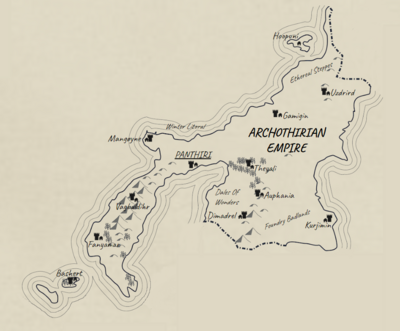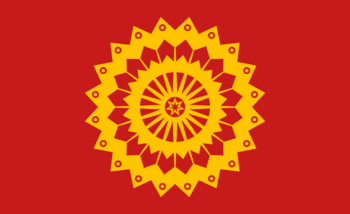Archothirian Empire (Aurora)
Archothirian Empire "Impero Arcotiriano" "Imperium Archothirium" "Aftokratoria Tonthirion" "𐎠𐎳𐎠𐎽𐎭 𐎧𐏁𐏂" | |
|---|---|
|
Flag of the Archothirian Empire. | |
 Map of Archothirian Dominions. | |
| History | |
| Location | Northern Zalora |
| Allies |
|
| Government | |
| Type | Constitutional monarchy |
| Ruling House | Malphasamael Dynasty |
| Head of State | Jophiel & Eisheth Malphasamael |
| Legislature | Council Of Royal Houses |
| Military | Archothirian Imperial Army |
| Socio-cultural characteristics | |
| Capital | Panthiri |
| Official languages | Archorian |
| National languages | Archorian Rolamtinu Elladan Cyrusian |
| Races | Beastfolk Clockworks Cloud Fae Dwarves Elementals Elohim Elves Gnomes Hybrids Humans Illusionals Orcs Sheseirim Triclops |
| Religion(s) | Fracturalism (Imperial Religion) Kpherism Siddarthism Shamanism Pattermajism Bashonastrism |
| Demonym(s) | Archothirian; Archian (more archaic and less used) |
| Population estimate | 37.7 million |
| Currency | Erpyon |
- Go back to Aurora - Go back to the List of nations.
The Archothirian Empire, also simply known as Archothiria (ɑɹkoʊθɪɹɪən; Archorian: Impero Arcotiriano) is a thaumaturgical empire based in northern Zalora. Archothiria borders with the Novus Daemonica Empire on it’s north, and the Obskaric Ocean on both it's east and west. The Empire's territories are highly diverse in both terrain and biome, and almost all of them are characterized by a varying degree of highly anomalous and magical characteristics, such as the extreme tundral-tropical temperature variations of the Winter Litoral, the floating islands of the Emunian Plains, and the paradoxically warped landscapes of Hoopuni. As such, a very large percentage of Archothirian fauna and flora are infused with and make use of magic. As of 1101, the Archothirian Empire spans a total of approximately 560.000 square toors, and has a total population of 37.7 million, currently making it the most populous empire in Aurora, as well as one of the most territorially expanded.
After the AngeloDemonic Wars of Unification of the first century, when the Elohimian Order and the Sheseirim Domain, now united under the single ruling dynasty of the Malphasamaels, conquered the other nations that had emerged in the area after the Fracture, bringing them all under a single banner. The Archothirian Empire was officially founded in 106 with the New Archian Imperial Constitution (Archorian: Nuova Costituzione Imperiale Archiana), that created the first institutions, laid the inner workings of the newborn Empire's government and administration, and established its first laws. The document, known as the Archothirian Constitution in the current age, is still in use almost a full millennium later, although it has gone through significal additions and changes since it's first ever draft.
The Archothirian Empire is inhabited by a wide variety of races, most of which originated from their ancestors who "fell" in Aurora's plane of reality following the Fracture. The only exceptions are Humans, who were already living in the area before the Fracture, and the Cloud Fae, whose mobile cloud hives first reached the Empire's territories in the 200s. All races within the Empire share equal status with one another, and over the centuries have thoroughly mixed with one another: most communities and settlements within Archothiria are highly cosmopolitan and diverse, with mono-racial communities having become rare and unusual. In recent years, as the Archothirian Empire put an end to it's nearly millenary period of isolation, new races like the Lightfolk and Belsedori have started to possess a token presence in the form of merchants and other travelers, mostly not on a permanent basis yet.
